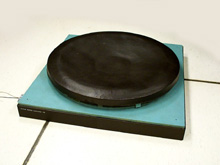 In some virtual training environments, movement is accomplished using
vehicles ranging in complexity from a bicycle to an F15 aircraft.
Typically, the purpose of these virtual environments is to train for
competence in the operation of the vehicle in the real world.
In some virtual training environments, movement is accomplished using
vehicles ranging in complexity from a bicycle to an F15 aircraft.
Typically, the purpose of these virtual environments is to train for
competence in the operation of the vehicle in the real world.
However, in other instances, operation of a vehicle is unrelated to
the training goal. A more appropriate interaction would allow the
trainee to walk through the virtual environment, because he or she walks
when performing the task in the real world. In these cases, expending
mental resources to control a vehicle-based interface may demand
attention which would better be devoted to the task to be trained.
Furthermore, for some real-world tasks, we grasp and manipulate
objects with our hands while we walk. If the interface requires the use
of the hands to control walking, then it can interfere with the control
of manual sub-tasks. For these applications, a hands-free,
body-operated walking interface is ideal; immersive environments
designed to train firefighters or foot-soldiers are good examples.
 One solution to a pedestrian interface is a 360-degree treadmill, which
would allow the user to interact in the virtual world using real-world
kinesthetic motions. We call this approach a "full-motion" interface.
In contrast, the HIT Lab has been developing prototypes of
"sufficient-motion" interfaces, which allow the user to interact by
using a subset of the real-world kinesthetic inputs. Though the ranges
of motion are less than full, these inputs are sufficient to convince
the user that he or she is moving in the virtual world. Our development
of these interface devices is called the Virtual Motion Controller (VMC)
Project.
One solution to a pedestrian interface is a 360-degree treadmill, which
would allow the user to interact in the virtual world using real-world
kinesthetic motions. We call this approach a "full-motion" interface.
In contrast, the HIT Lab has been developing prototypes of
"sufficient-motion" interfaces, which allow the user to interact by
using a subset of the real-world kinesthetic inputs. Though the ranges
of motion are less than full, these inputs are sufficient to convince
the user that he or she is moving in the virtual world. Our development
of these interface devices is called the Virtual Motion Controller (VMC)
Project.
The HIT Lab's VMC working prototype measures body position over the
working surface with an arrangement of four weight sensors. The curved
working surface provides important feedback to the user about his or her
physical location, and therefore body locomotion input to the device. A
head-tracker worn by the user measures yaw axis motion of the head,
which controls the view orientation. This combination of inputs
facilitates natural and independent control of travel direction and gaze
direction. Other conceptual prototypes will be capable of operating
without the head tracker, working instead with panel-mounted display
screens (projector screens).
Currently, we are building virtual worlds in which to evaluate
participant performance when using a VMC. We will compare the quality
of the user's navigation and spatial awareness when using a VMC to that
demonstrated using other interaction techniques.
Also see the VMC Experiment done by
Barry Peterson.
 In some virtual training environments, movement is accomplished using
vehicles ranging in complexity from a bicycle to an F15 aircraft.
Typically, the purpose of these virtual environments is to train for
competence in the operation of the vehicle in the real world.
In some virtual training environments, movement is accomplished using
vehicles ranging in complexity from a bicycle to an F15 aircraft.
Typically, the purpose of these virtual environments is to train for
competence in the operation of the vehicle in the real world. One solution to a pedestrian interface is a 360-degree treadmill, which
would allow the user to interact in the virtual world using real-world
kinesthetic motions. We call this approach a "full-motion" interface.
In contrast, the HIT Lab has been developing prototypes of
"sufficient-motion" interfaces, which allow the user to interact by
using a subset of the real-world kinesthetic inputs. Though the ranges
of motion are less than full, these inputs are sufficient to convince
the user that he or she is moving in the virtual world. Our development
of these interface devices is called the Virtual Motion Controller (VMC)
Project.
One solution to a pedestrian interface is a 360-degree treadmill, which
would allow the user to interact in the virtual world using real-world
kinesthetic motions. We call this approach a "full-motion" interface.
In contrast, the HIT Lab has been developing prototypes of
"sufficient-motion" interfaces, which allow the user to interact by
using a subset of the real-world kinesthetic inputs. Though the ranges
of motion are less than full, these inputs are sufficient to convince
the user that he or she is moving in the virtual world. Our development
of these interface devices is called the Virtual Motion Controller (VMC)
Project.